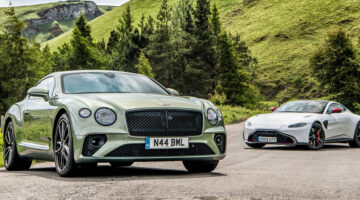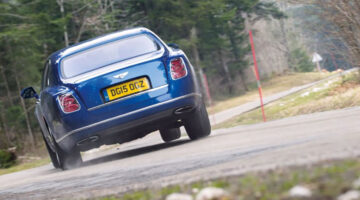In 1928, Sir Henry ‘Tim’ Birkin was convinced a supercharged 4 ½ Litre engine would make Bentley dominant again. It didn’t. But Birkin’s ‘Blower’ did go on to create a legacy across the next 89 years
| Engine | Power | Torque | 0-100kph | Top speed | Weight | Basic price |
|---|---|---|---|---|---|---|
| Inline 4cyl, supercharged, 4,398cc | 175bhp @ 3,500rpm (road), 240bhp @ 2,400rpm (race) | 'Sufficient' | c8.0 secs | c195kph (road) | 1727kg (101bhp/ton) | Sorry, not for sale |
It’s not something that usually concerns me ahead of a test drive, but today I feel almost embarrassingly under-dressed for the model before me. It’s a 1930 Bentley 4 ½ Litre Supercharged, more commonly known as The Blower. It’s almost certainly the most famous pre-war Bentley ever produced, undoubtedly the fastest model of its era, and is up there with World Cup relegation and Enid Blyton stories as the quintessence of Britishness. Standing as I am before the 14ft-long supercharged behemoth – effectively motorsport royalty – suddenly a tweed jacket, a pipe and a bushy moustache feel more in-keeping than my weathered jeans and converse.
Fortunately Richard Charlesworth, Bentley Ambassador and crankandpiston’s partner in crime for the day, has the latter covered, decked out as he is in pristine Bentley shirt and a cloth cap I can only imagine he’s borrowed from Bertie Wooster (although he refrains from wearing it on our drive, for fear of losing it). Following a 41-year career at Crewe, a now semi-retired Richard is both a brand ambassador and custodian of the Blower – part of the marque’s ever growing ‘Legacy’ collection – we’ll be taking for a spin this afternoon. The sheer size alone warrants pre-drive jitters, but frankly so too does its history.
In much the same way Jim Clark would become synonymous with Lotus and Aryton Senna with McLaren in Grand Prix racing’s later years, in the late 1920s, so too did Sir Henry ‘Tim’ Birkin represent Bentley, albeit strictly against his family’s wishes. As part of ‘The Bentley Boys’, a collection of illustrious – and wealthy – British playboys with a united passion for racing, Birkin helped the marque establish British dominance on-track across the decade: between 1923 and 1930, a Bentley lost only three times at Le Mans and usually took the chequered flag several laps ahead of its nearest rivals.

By 1928 though, Birkin felt the time had come to re-open the performance gap to the competition. To company founder – and chief engineer – W.O. Bentley, the solution lay with a larger capacity engine, a theory that passed significant muster. Bentley’s new 6½ Litre Speed Six produced 147bhp (considerably more than its rivals could manage), would go on to win Le Mans in both 1929 and 1939, and would be commemorated by Bentley’s Speed 8 Le Mans prototype during a successful factory return to La Sarthe in 2003.
Birkin though felt the answer lay with supercharging, and going over W.O. Bentley’s head – a move the old man did not take kindly – Birkin commissioned independent engineer Amherst Villiers to design and develop a supercharger for the five 4 ½ Litre ‘Blowers’ that would race and the 50 road-going models required for homologation. With W.O. Bentley’s chequebook out of bounds, the necessary financial clout was sought from wealthy American heiress Dorothy Paget, a notable racehorse owner whose steeds had netted 1532 wins, and, from a purely competition perspective, tweaked her interest in motorsport. It helped immensely that the Hon. Paget was also barking mental, barely batting an eyelid at the costs required for the 4 ½ Litre Supercharged program: it would be a tidy six figure sum in today’s money.
“Standing before motorsport royalty, suddenly a tweed jacket, a pipe and a bushy moustache feel more in-keeping than my weathered jeans”
Head-turning drives would follow though. With power increased from 110bhp to around 175bhp (the race cars had bigger SU carburettors and produced up to 240bhp), Birkin himself battled Mercedes’ 7.1-litre supercharged challenger at the 1930 24 Hours of Le Mans at speeds of up to 200kph at a time when driver safety was non-existent. At the 1930 French Grand Prix, at which Birkin took a fighting second place in the near two-ton Blower against a field of much lighter Bugatti GP machinery, Ettore Bugatti famously referred to the Blower as ‘the world’s fastest lorry’. Success, however, would remain at arm’s length, W.O. Bentley’s assumption that reliability would scupper the supercharged Blower’s chances proving accurate. Not that this has affected the Blower’s legacy of course…

“This was actually the first heritage Bentley we acquired,” Richard explains with a ruminating wipe of his sunglasses. “When Bentley was bought by Rolls-Royce in 1931, everything was sold off, so in 1997, I persuaded the company to buy this particular car at auction at the Goodwood Festival of Speed. It epitomised the spirit of Bentley in the 1920s, and it helps people understand where we’re from and why we build the cars we do today. Plus, we spent £360,000 (c$445K), which is not bad when you consider it’s worth several million now.
“This particular model went through, I think, six different owners just in the ‘30s, and then a chap called Hardy, who owned it for around 50 years, bought it in 1942. Interestingly, he flew a Tiger Moth plane, so he maintained the car in much the same fashion: if the fabric got a hole in it, he would just stick a bit of glue on and patch it. He also changed a lot of the instrumentation, so when we got it, it was in original condition, but quite tired. Luckily all the important bits – the crankcase, the block, the suspension, the transmission, the brakes, etc – were all original, and the ash frame was virtually intact, so all we had to do was refit and redo the interior.”
By my right ear, the 4,398cc four-cylinder is idling away, the sounds of miniature explosions and a multitude of ‘pops’ and ‘bangs’ doing their best to recreate the atmosphere of pre-war Aintree. It sounds spectacularly bonkers.
“You don’t want the door to fail through a 100kph corner, now do you?”
Alighting, the insanity continues. There is no door on the driver’s side, so to get behind the wheel requires shimmying across from the passenger side. Bizarre as this might sound, the design was a safety feature, since neither the door – which hinges backwards à la Rolls-Royce Phantom – nor the locks are particularly strong on the passenger side. And you don’t want the door to fail through a 100kph corner, now do you? Curiosity sated, I reach with vigour for my seatbelt, only to find there isn’t one. Easy through the corners Richard…

The seats though are glorious, clad with not-quite-racing-green leather and cushioned just enough to take the edge off the springs below. The floor stretching deep into the footwell is wooden – surprisingly, for a Bentley, there’s no carpet at all – to match the vinyl-wrapped ash frame beneath it. I can even feel the supercharged engine whirring away through the sole of my shoe. The dash meanwhile is splashed with Jaeger and Smiths dials and gauges, the most significant of which – oil and water temperature – are in front of the driver. Curiously, the passenger has the speedometer, despite the fact that the race trimmed 240bhp Blower could hit record speeds of 137.96mph (c222kph) at Brooklands.
Most of the visual bulk stretches out across the enormous bonnet towards the vertical radiator and the outboard-mounted supercharger. From almost 8ft back, you can’t see the wings at all, meaning the high-mounted headlights are your only reference point. Mercifully, the throttle has been repositioned from its original centre position to the more conventional right, while the four-speed manual gearbox stands next to the driver’s right leg like a ghastly prosthetic limb. Even starting it is a marathon. It involves groping under the dashboard for the electrical master switch, flicking the fuel switch, tugging on the brass magneto switches and the ignition quadrant, then thumbing the black starter. A mighty heave on the handbrake, which is mounted on the outside of the body, naturally, and the big British brute is rolling.
“I can feel the supercharged engine whirring away through the sole of my shoe”
“This car has been all over the world,” Richard proffers as way of an introduction as the Blower works its shouty and very obvious presence onto the road. “Most years it’s sent to Pebble Beach Concours, it’s taken part in the Quail Rally, it’s been to the Middle East, Moscow, New York, Beijing, Shanghai, and it’s rallied in various parts of the world, particularly in Europe on the Mille Miglia. So it’s a car that’s used and enjoyed, not stuck in a glass box and admired from afar.” Richard then proceeds to tell me a story about the time he and the Blower were in Los Angeles, when a black Cadillac Escalade – tinted windows, natch – pulled up alongside him, and an incredibly large gentleman got out to ask how much the car was worth. Turns out Richard has some stones to match that moustache.
He’s also a sportsman, and when the two-ton bruiser hits a set of traffic lights, he reaches into the backseat and retrieves an era-spec ‘helmet’ – it’s just a piece of leather – and a set of driving goggles. Unfortunately he doesn’t have the tweed jacket or pipe.
Story concludes on page 2



